 Continuing our looksee at all the games produced by a single software house, this issue we'll look at some of the quite extensive catalogue of Adventure International releases. The early days of home computing got away with the 'text adventure', best thought of as a puzzle game whereby you read various location descriptions trying to identify clues as to how it should be completed. Nowadays the concept seems quite dull, with graphical point-and-click adventures offering the same functionality but with graphics and without parser limitations.
Continuing our looksee at all the games produced by a single software house, this issue we'll look at some of the quite extensive catalogue of Adventure International releases. The early days of home computing got away with the 'text adventure', best thought of as a puzzle game whereby you read various location descriptions trying to identify clues as to how it should be completed. Nowadays the concept seems quite dull, with graphical point-and-click adventures offering the same functionality but with graphics and without parser limitations.
For the purposes of this article, I am restricting myself to the bastion of the Adventure International stable - the Scott Adams Adventures, for no other reason than, were I to cover the whole catalogue in a single article, it would probably be so long that most of you would give up reading before you got to the end. I am also basing the article at an absolute newcomer to the 'text adventure' genre. Most of its information may be familiar to you old hands out there. I should also profess something of a dislike for most of Scott Adams' wares, and I feel that of all adventures they have aged the most terribly. All of the images that illustrate this article come from the original cassette release's cover art - much more interesting to look at than text, I'm sure you'll agree.
 Adventureland is the first of the fifteen, describing itself on its back cover as an Adams 'classic' to try and uncover thirteen lost treasures (which are not particularly well hidden). Even on its release for the BBC/Electron, Adventureland was a dated piece of software, originally written for a Texas Instruments 16K machine in 1977, and converted (purposefully) with no noticeable improvements to "preserve" it. Mill about a landscape of dragons and chiggers collecting treasures and return them to a specific location then say SCORE. Um, what the heck are chiggers?
Adventureland is the first of the fifteen, describing itself on its back cover as an Adams 'classic' to try and uncover thirteen lost treasures (which are not particularly well hidden). Even on its release for the BBC/Electron, Adventureland was a dated piece of software, originally written for a Texas Instruments 16K machine in 1977, and converted (purposefully) with no noticeable improvements to "preserve" it. Mill about a landscape of dragons and chiggers collecting treasures and return them to a specific location then say SCORE. Um, what the heck are chiggers?
This is a beginners' adventure which you can navigate quite easily without making a map, although it does include a random element which, if you're unlucky, can make it uncompletable. This occurs in trying to ease past some killer bees to collect some royal honey. The bees will usually leave you alone but sometimes they will sting you to death, necessitating you to save the game before taking the risk! This is one of the quirks of Scott Adams' adventures - use of a save game routine as a feature of the adventure - and it is something which should have been avoided, especially in beginners' fare.
 The same observations also hold good for Pirate Adventure which is, and was, probably only enjoyed by players who had physically consumed copious quantities of rum before booting it up. Whilst the goal is clear - recover two treasures from Treasure Island and bring them back to your London flat - you are introduced early on to the bizarre command SAY YOHO which Adams went on to include in many of his other adventures. It is something of an in-joke because of its inherent randomness; saying it in Pirate Adventure transports you, for no discernible reason, over countless countries and continents. Hence the command is useful; and as a last resort people have tried it in all other text adventures since, usually to be given weird responses.
The same observations also hold good for Pirate Adventure which is, and was, probably only enjoyed by players who had physically consumed copious quantities of rum before booting it up. Whilst the goal is clear - recover two treasures from Treasure Island and bring them back to your London flat - you are introduced early on to the bizarre command SAY YOHO which Adams went on to include in many of his other adventures. It is something of an in-joke because of its inherent randomness; saying it in Pirate Adventure transports you, for no discernible reason, over countless countries and continents. Hence the command is useful; and as a last resort people have tried it in all other text adventures since, usually to be given weird responses.
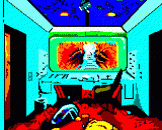 Secret Mission (or Mission Impossible on some other formats) is probably one of the better Adams' offerings, and is the first to play with the traditional 'bring items to the treasure room and say SCORE to win'. A saboteur is on the run in a nuclear reactor and you, as Mr. Phelps, need to disarm him and his bomb. Whilst this adventure has some nice touches - the saboteur running around trying to outwit you as you calmly press a white button to blow him up, for one! - it is also a prime contender for illustrating the type of parser problems these early adventures included. You need to search the saboteur early on in the game. The specific command FRISK SABOTEUR is the only one which is accepted - something that it took its original players many, many months to work out.
Secret Mission (or Mission Impossible on some other formats) is probably one of the better Adams' offerings, and is the first to play with the traditional 'bring items to the treasure room and say SCORE to win'. A saboteur is on the run in a nuclear reactor and you, as Mr. Phelps, need to disarm him and his bomb. Whilst this adventure has some nice touches - the saboteur running around trying to outwit you as you calmly press a white button to blow him up, for one! - it is also a prime contender for illustrating the type of parser problems these early adventures included. You need to search the saboteur early on in the game. The specific command FRISK SABOTEUR is the only one which is accepted - something that it took its original players many, many months to work out.
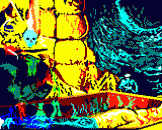 The fourth adventure, Voodoo Castle is the only adventure in the series not written by Scott but by his wife Alexis. It is probably the most limited of all, completely linear, without treasures and with only very simple commands being accepted. The Count lies near death in the castle of the title and only a very strange voodoo ritual is likely to save him. The location descriptions are spartan and commands such as CIRCLE COFFIN and YELL CHANT are not likely to occur to even the most seasoned adventurers, even with the help which is offered.
The fourth adventure, Voodoo Castle is the only adventure in the series not written by Scott but by his wife Alexis. It is probably the most limited of all, completely linear, without treasures and with only very simple commands being accepted. The Count lies near death in the castle of the title and only a very strange voodoo ritual is likely to save him. The location descriptions are spartan and commands such as CIRCLE COFFIN and YELL CHANT are not likely to occur to even the most seasoned adventurers, even with the help which is offered.
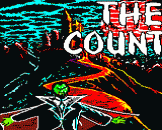 The theme of vampires continues - although this time the objective is to kill instead of save one - in The Count. Again, as Scott Adams' adventures go, I find this one of the better ones as it takes place over a number of days, forcing you to return to bed and sleep between. It also introduces large elements of misdirection. Moves which do not advance the game correctly in most adventures are simply poohpoohed. Yet here such actions as examining a watch and placing the mirror in your bed appear to be significant but in fact do nothing at all apart from distract you.
The theme of vampires continues - although this time the objective is to kill instead of save one - in The Count. Again, as Scott Adams' adventures go, I find this one of the better ones as it takes place over a number of days, forcing you to return to bed and sleep between. It also introduces large elements of misdirection. Moves which do not advance the game correctly in most adventures are simply poohpoohed. Yet here such actions as examining a watch and placing the mirror in your bed appear to be significant but in fact do nothing at all apart from distract you.
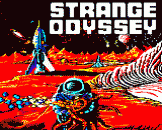 Again, try as I might to diss Scott's offerings, there is no denying that he exploited the text adventure potential in every genre. His sixth course, Strange Odyssey, is set in deep space as your one-man scoutship lands on a strange, yet colonised, planet. He has reverted to the treasure hunt, albeit combined with liftoff back to earth, and there are only a limited number of rooms apart from the interior of your ship. However, as with The Count, the descriptions are somewhat more evocative and, apart from yet another random 'you might get killed by a bloodhound unless you save the game' feature (Ugh!), it's quite enjoyable.
Again, try as I might to diss Scott's offerings, there is no denying that he exploited the text adventure potential in every genre. His sixth course, Strange Odyssey, is set in deep space as your one-man scoutship lands on a strange, yet colonised, planet. He has reverted to the treasure hunt, albeit combined with liftoff back to earth, and there are only a limited number of rooms apart from the interior of your ship. However, as with The Count, the descriptions are somewhat more evocative and, apart from yet another random 'you might get killed by a bloodhound unless you save the game' feature (Ugh!), it's quite enjoyable.
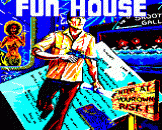 As with Mr. Phelps, there aren't any 'official' James Bond 007 adventures on the Electron so Mystery Fun House is the closest you are going to get to playing the man himself. It is strange to think that, back in the early Eighties, copyright infringments, and multi-million pound settlements on the back of them, had not yet come to the fore, hence Mr. Adams saw no potential problems in writing an adventure with Ian Fleming's secret agent as its main protagonist. This adventure is one of the first complicated puzzlers where you need to complete a "chain" of moves in a set manner. Its parser limitations are just as evident as always however with the CHEW GUM, STICK GUM, TO BRANCH, GET DOLLAR, WITH BRANCH combinations in the startgame leading to many sleepless nights.
As with Mr. Phelps, there aren't any 'official' James Bond 007 adventures on the Electron so Mystery Fun House is the closest you are going to get to playing the man himself. It is strange to think that, back in the early Eighties, copyright infringments, and multi-million pound settlements on the back of them, had not yet come to the fore, hence Mr. Adams saw no potential problems in writing an adventure with Ian Fleming's secret agent as its main protagonist. This adventure is one of the first complicated puzzlers where you need to complete a "chain" of moves in a set manner. Its parser limitations are just as evident as always however with the CHEW GUM, STICK GUM, TO BRANCH, GET DOLLAR, WITH BRANCH combinations in the startgame leading to many sleepless nights.
 The blurb to Pyramid Of Doom proved particularly ironic, proclaiming "jewels, gold, it's all here for the plundering... if you can find the way!" Unfortunately, due to a last minute programming 'upgrade', when the Electron release first came out, the pyramid location was left out! Oh, how many poor adventures wandered around in the desert for hours trying to find the way when the way was never going to reveal itself?! We can only imagine. On top of this bug, which was fortunately corrected in time for most batches to hit the shelves, yet again you had random elements in Pyramid Of Doom. There isn't a lot more to be said about it, only that it's a search and retrieve treasure hunt rather like all of the others (Sigh!) with nothing really to set it apart.
The blurb to Pyramid Of Doom proved particularly ironic, proclaiming "jewels, gold, it's all here for the plundering... if you can find the way!" Unfortunately, due to a last minute programming 'upgrade', when the Electron release first came out, the pyramid location was left out! Oh, how many poor adventures wandered around in the desert for hours trying to find the way when the way was never going to reveal itself?! We can only imagine. On top of this bug, which was fortunately corrected in time for most batches to hit the shelves, yet again you had random elements in Pyramid Of Doom. There isn't a lot more to be said about it, only that it's a search and retrieve treasure hunt rather like all of the others (Sigh!) with nothing really to set it apart.
 Next came Ghost Town in which the difficulty rating hit an all-time high. In one location, you had to ride a horse with the command SAY GIDDYUP; in another, you have to DANCE in a saloon to win a prize. No indication of either was given in any of the accompanying text. You also had the very curious inclusion of a treasure in the form of an ornamental go board (of the Acornsoft Go ilk!) and then the command PASS GO which, in a nod to Monopoly, gave you another treasure of $200!! What this had to do with the Wild West was tentative (at best!) and how anyone would have made this connection fair boggles my mind.
Next came Ghost Town in which the difficulty rating hit an all-time high. In one location, you had to ride a horse with the command SAY GIDDYUP; in another, you have to DANCE in a saloon to win a prize. No indication of either was given in any of the accompanying text. You also had the very curious inclusion of a treasure in the form of an ornamental go board (of the Acornsoft Go ilk!) and then the command PASS GO which, in a nod to Monopoly, gave you another treasure of $200!! What this had to do with the Wild West was tentative (at best!) and how anyone would have made this connection fair boggles my mind.
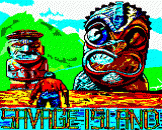 The infamous Savage Island Part One follows, cranking up the difficulty level to impossible levels, with hitting certain scenes determined by odds of one in a hundred! The premise of this adventure, set on an isolated desert island, was frankly barking mad. The first part had some semblance of normality, although your mission, to discover the secret of a temple, was by no means clear. By Savage Island Part Two, Adams was combining science fiction with prehistoric man and even supplying coded "What this was all about" leaflets with the game itself. Personally I don't believe anyone ever completed either part of this adventure without a full walkthrough beside them. Not only are they completely devoid of logic but the lack of a clear goal means every move is simply a best guess, wihch is the last thing adventurers look for in their games.
The infamous Savage Island Part One follows, cranking up the difficulty level to impossible levels, with hitting certain scenes determined by odds of one in a hundred! The premise of this adventure, set on an isolated desert island, was frankly barking mad. The first part had some semblance of normality, although your mission, to discover the secret of a temple, was by no means clear. By Savage Island Part Two, Adams was combining science fiction with prehistoric man and even supplying coded "What this was all about" leaflets with the game itself. Personally I don't believe anyone ever completed either part of this adventure without a full walkthrough beside them. Not only are they completely devoid of logic but the lack of a clear goal means every move is simply a best guess, wihch is the last thing adventurers look for in their games.
 I am surprised to see he also billed Golden Voyage as of the same difficulty as it simply not. You have a fair idea of your mission - to recover a magical elixir for the King (for which he gives you a load of gold in advance, trusting sort that he is!) in the next three days. You therefore need to set about collecting the tools for the voyage, buying a ship and setting sail. Yes, it is a large chain-style puzzle and the location descriptions are not great, but to suggest it is on the same level as the Savage Island duo is ridiculous.
I am surprised to see he also billed Golden Voyage as of the same difficulty as it simply not. You have a fair idea of your mission - to recover a magical elixir for the King (for which he gives you a load of gold in advance, trusting sort that he is!) in the next three days. You therefore need to set about collecting the tools for the voyage, buying a ship and setting sail. Yes, it is a large chain-style puzzle and the location descriptions are not great, but to suggest it is on the same level as the Savage Island duo is ridiculous.
 His lucky thirteenth adventure is The Sorceror Of Claymorgue Castle, a departure from the BBC/Electron 'run' of adventures both in style and presentation. The instructions given are more complete, and you are tasked with recovering thirteen stars by casting spells at the correct locations. The vocabulary is complicated, with such commands as CAST PERMEABILITY SPELL being par for the course. You've got a YOHO spell also in a nod to Pirate Adventure. I have to confess I have only ever played this one with a walkthrough (and so may have missed some of the fun!) but without one it's unforgiving and death never seems more than a few moves away.
His lucky thirteenth adventure is The Sorceror Of Claymorgue Castle, a departure from the BBC/Electron 'run' of adventures both in style and presentation. The instructions given are more complete, and you are tasked with recovering thirteen stars by casting spells at the correct locations. The vocabulary is complicated, with such commands as CAST PERMEABILITY SPELL being par for the course. You've got a YOHO spell also in a nod to Pirate Adventure. I have to confess I have only ever played this one with a walkthrough (and so may have missed some of the fun!) but without one it's unforgiving and death never seems more than a few moves away.
 Originally, Scott Adams wrote fifteen individual adventures for the TI 99 but for some inexpliable reason the fourteenth one Return To Pirate's Isle was not converted for the BBC/Electron. His fifteenth, Buckaroo Banzai, was released but not as a standalone cassette but only as part of the Scott Adams Scoops compilation by U.S. Gold. Alas, it was also released crippled, and crashes as soon as you get into the jetcar, hence I'm not going to say too much about it here.
Originally, Scott Adams wrote fifteen individual adventures for the TI 99 but for some inexpliable reason the fourteenth one Return To Pirate's Isle was not converted for the BBC/Electron. His fifteenth, Buckaroo Banzai, was released but not as a standalone cassette but only as part of the Scott Adams Scoops compilation by U.S. Gold. Alas, it was also released crippled, and crashes as soon as you get into the jetcar, hence I'm not going to say too much about it here.
To conclude (and sigh with relief), even dressing up the Scott Adams adventures with snazzy loading graphics cannot hide that they are relics of a bygone computer age. As you can probably tell, I don't find many of them very exciting and really think they were only useful in influencing their evolutionary modern day graphical counterparts (Think Secret Of Monkey Island on the iPod touch!). To that end, I am going to move away from text adventures in the next issue of EUG and instead look at the small catalogue of IJK titles. I will come back to Adventure International's other releases, of which there are a multitude, some other time. Nevertheless, I hope you enjoyed this trawl through them and, who knows, it may have piqued the interest of a few of you to have a bash at them.